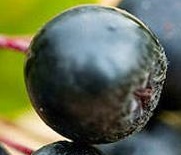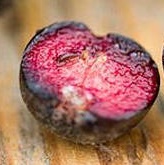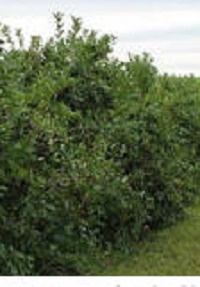
Looking for Aronia berries (also called Chokeberries) in 2025? Scroll down this page and follow the links. And if you bring home some fruit or vegetables and want to can, freeze, make jam, salsa or pickles, see this page for simple, reliable, illustrated canning, freezing or preserving directions. There are plenty of other related resources, click on the resources dropdown above. If you are having a hard time finding canning lids, I've used these, and they're a great price & ship in 2 days.
If you have questions or feedback, please let me know! There are affiliate links on this page. Read our disclosure policy to learn more.
Aronia berries (also called Chokeberries)
Aronia berries (also called Chokeberries)
 "chokeberry" is often confused
with "chokecherry." which is the common name for a different plant, prunus
virginiana
"chokeberry" is often confused
with "chokecherry." which is the common name for a different plant, prunus
virginianaAronias are an edible fruit crop, high in high-antioxidants, although the fruit is too astringent to eat raw so it is usually baked, made into jams, jellies, syrup, tea, juice and wine. Aronia berries contain high levels of vitamins, antioxidants, and polyphenols that reduce the potential for cancer and heart disease. Products made from chokeberries include jams, jellies, juice and Aronia wine.
The berries can survive on the bush into winter , if birds and other wildlife don't eat them first.
The berries
Aronia melanocarpa, black chokeberry, the juicy pea sized
berries (botanically a pome) are black in color and contain 1 to 8
seeds. Black chokeberry is grown commercially for juice production.
Aronia arbutifolia, red chokeberry, has attractive red fruit and is grown as an ornamental. Both species are edible but the highly tart / acidic tannin content makes your mouth pucker when you eat the berries resulting in the name chokeberry.. The red variety is rarely grown commercially.
There is also a Purple chokeberry, Aronia prunifolia (Photinia floribunda) which is rarely grown commercially
Where aronias are grown
There are two species of Aronia that belong to the rose family and are found in the eastern parts of North America from southern Canada to Georgia, west to Arkansas and north to Minnesota. They are slow growing, long lived suckering deciduous shrubs about 6 feet tall and wide with the general appearance of a lilac bush. They are also grown in Russia and Poland, where by 1985 over 40,000 acres of black chokeberry was grown in Russia. Poland had 10,000 acres under production in 2005. The fruit is mainly marketed as a juice or jams there. An aronia wine is made in Lithuania,
In the Spring, the bush has showy white flower clusters. In autumn, leaves change from green to vibrant tones of red, orange and purple.
When
Aronia's bloom in mid-May to mid-June
The berries are harvested from late August to mid-September, but as noted above, they may survive on the bushes into winter.
Cooking and preserving
Aronia berries can be made into jams and jellies much like blueberries or cranberries. They are very tart, so you may find you add more sugar.
You can find our fully illustrated, step by step directions here for making Aronia jelly and Aronia Jam
Basic recipes are shown below forl Aronia berry jam and jelly
Aronia jam
Yield about 6 to 8 half-pint jars
Ingredients
- 6 cups aronia berries.
- 1/2 cup fresh lemon juice
- 1 (1 3/4 ounce) package dry pectin (no-sugar needed type is most reliable)
- 6 cups sugar
Steps
- Wash the berries and then put them in a pot with enough water to cover them
- simmer 15 minutes until they become soft and mushy
- Add pectin and mix thoroughly
- Bring to a full hard boil; then add the sugar and stir continuously.
- Return to a full rolling boil and boil then for 1 minute
- Skim off any foam and ladle into canning jars.
- Wipe the rims and put on lids and rings
- Process in boiling water bath for five minutes
- Let cool away from drafts, undisturbed until room temperature (4 - 6 hours)
- Check for proper sealing and store in a cool, dry, dark place
Aronia jelly
Yield about 6 to 8 half-pint jars
Ingredients
- About 4 lbs of aronia berries to produce 3 and 1/2
cups chokecherry juice made from the berries in steps 1-3 below
if you don't have enough berries to make 3.5 cups of juice, you can supplement it with canned commercial apple juice, blueberry juice, cranberry juice, etc. - 1/2 cup fresh lemon juice
- 1 (1 3/4 ounce) package dry pectin (no-sugar needed type is most reliable)
- 6 cups sugar
Steps
- Wash the berries and then put them in a pot with enough water to cover them
- simmer 15 minutes until they become soft and mushy
- Strain the juice. in a strainer or screen
- return to a clean pot
- Add pectin and mix thoroughly
- Bring to a full hard boil; then add the sugar and stir continuously.
- Return to a full rolling boil and boil then for 1 minute
- Skim off any foam and ladle into canning jars.
- Wipe the rims and put on lids and rings
- Process in boiling water bath for five minutes
- Let cool away from drafts, undisturbed until room temperature (4 - 6 hours)
- Check for proper sealing and store in a cool, dry, dark place
Varieties of Black Chokeberries
Common Aronia / Black chokeberry varieties are:
- 'Autumn Magic' - compact bush with large abundant fruit clusters
- var. elata - large abundant fruit clusters, reduced suckering
- Iroquois Beauty™ - compact bush
- 'Viking' - large abundant fruit clusters
Aronia Berry (Chokeberry) Production in Iowa
A two day event about sustainable organic commercial production and home garden culture of black chokeberry (Aronia melancarpa) was held in August 2008. For more information about future events, commercial production and marketing of aronia berries, visit Everhart Horticulture Consulting. Dr. Eldon Everhart, formerly with Iowa State University, is co-owner of Everhart Horticulture Consulting.
But chokeberries are NOT chokecherries...
Chokecherry - The Chokecherry
(Prunus virginiana) is similar in its habitat
preferences to the saskatoon. The white flowers, appearing in late May to early
June, form long bottle-brush like clusters. The fruits ripen in August, and can
be yellow, orange, red or dark purple in color. The fruit is astringent, but
makes good jellies, jams and sauces. Other parts of the plant were used by
native peoples for medicinal purposes. The roots were chewed and placed on
wounds to prevent bleeding, and the bark was boiled with other ingredients to
treat diarrhea and fever. Chokebcherries can be propagated from seed, cuttings,
suckers and crown division.
Looking for canning equipment and supplies?
Water bath canner with a jar rack
Pressure canners for gas, electric and induction stoves: Presto 23Qt or T-fal 22Qt
Canning scoop (this one is PERFECT)
Ball Blue book (most recent version)
Jars: 8oz canning jars for jams
Find Other types of farms:
Farm markets and roadside stands
Road trips and camping resources
Local Honey, apiaries, beekeepers
Consumer fraud and scams information
Home canning supplies at the best prices on the internet!
Maple Syrup Farms, sugarworks, maple syrup festivals
Environmental information and resources
Farms For Your Event for birthday parties, weddings, receptions, business meetings, retreats, etc.
Festivals - local fruit and vegetable festivals
Get the
most recent version of
the Ball Blue Book
With this Presto 23 quart pressure canner and pressure cooker, you can "can" everything, fruits, vegetables, jams, jellies, salsa, applesauce, pickles, even meats, soups, stews. Model 01781

You can make jams, jellies, can fruit, applesauce, salsa and pickles with water bath canners, like this Granite Ware 12-Piece Canner Kit, Jar Rack, Blancher, Colander and 5 piece Canning Tool Set

